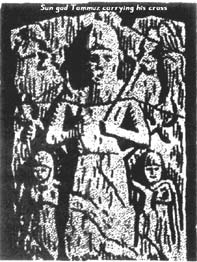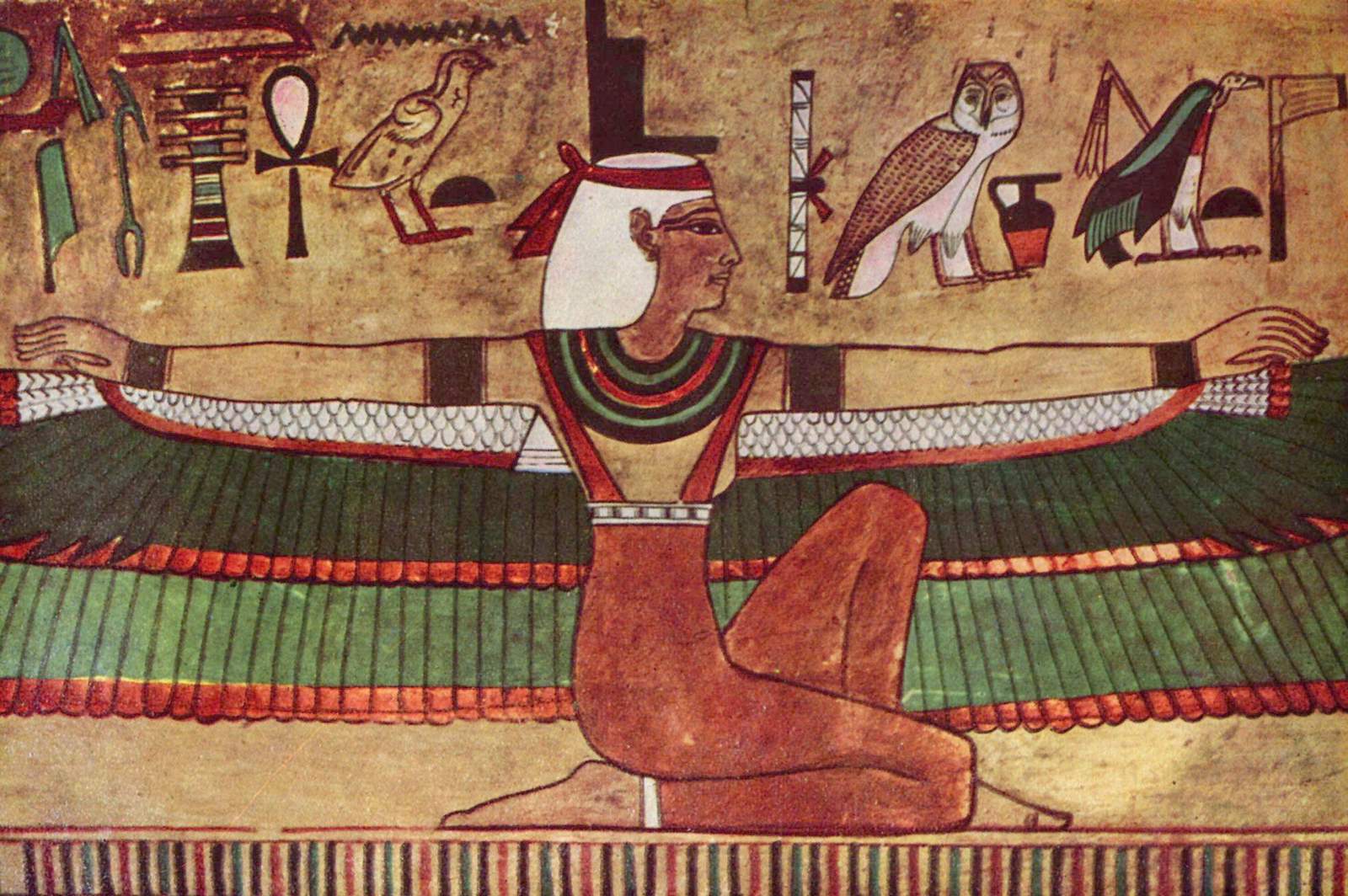[35]
Let us substitute
enchantment for sentiment,
re-dedicate our gifts
to spiritual realism,
scrape a palette,
point pen or brush,
prepare papyrus or parchment,
offer incense to Thoth,
the original Ancient-of-days,
Hermes-thrice-great,
let us entreat
that he, by his tau-cross,
invoke the true-magic,
lead us back to the one-truth,
let him (Wisdom),
in the light of what went before,
illuminate what came after,
re-vivify the eternal verity.
be ye wise
as asps, scorpions, as serpents.
The theme of magic and references to magical Egyptian symbols continues in section 35. The openning advises us to replace sentiment (Personal experience, one's own feeling, Sensation, physical feeling. In later use, a knowledge due to vague sensation) with enchantment (The action or process of enchanting, or of employing magic or sorcery, Alluring or overpowering charm; enraptured condition; (delusive) appearance of beaut). The rededication of gifts to spiritual realism, if you excuse the pun, is truly openning pandora's box. In the modern sense, spiritual realism is a kind of off-shoot from new age sciences. There is however an interesting kernel of truth to be explored in the idea of spiritual realism, rather than the ideas that comprise it. Spiritual realism is a departure from the imagistic nature of main stream religions, and even the sometimes overly ritualized mysticisms that connote the deeper understandings of the top level religions. Spiritual Realism is an attempt to understand spirituality in an ulinked state from the usual totemic images of spirituality, mainstream, fringe, dogmatic, pagan or otherwise. Spiritual Realism in its modern "crystal-crunchy" state didn't exist in quite the same context during HD's life, but rather the idea that gifts should be offered to the real experience of spirituality, something tangible like a glorious sunrise, or any other touchstone of divinity, is an interesting one considering that this section is bookended by magic and vipers and the preceeding section which deals with Egyptian and Greek Gods and Goddesses. To "scrape a pallet /point pen or brush" continues on this theme of spiritual realism but recasts it in the form of Art. The new divine is on the canvas and that the artist is a kind of modern priest capable of tapping into those energies historically reserved for ecclesiastical orders and what not. The artist as priest or a kind of demagogue? Is HD saying that perhaps the artist has the power to help us understand that the myth isn't here to elucidate the truth, but to show our place in the narrative in the same way that a sermond reminds us, theosophically, of our place and part in the story of Divine (granting depending on the amount of brimstone you take in your cup o church).

We are pulled back into the pantheon of Egyptian Gods as we are advised to offer Thoth incense. Thoth was one of the more important gods of the Egyptian Pantheon having helped Isis work her magic to bring Osiris back to life and aiding her son Horus in his battle against Set. He is a powerful wielder of magic and also has a female counterpart in the form of Ma'at. This is where things get a little interesting if you ask me.

Ma'at embodies the ancient Egyptian's concepts of morality, law and justice. She is the weigher of words in the underworld and a perfect simulacrum of Plato's logos. What is more astounding, when you consider that woman had nearly no status in Greek society, wasn't supposed to leave the house alone, etc. etc. was given governence in ancient Egypt over these ideal and important concepts dealing with the ethical issues. The Greeks, as HD mentions, referred to Thoth as Hermes, or rather Hermes came from the concept of Thoth, but she is going back to the source of all things. The Triology doesn't deal with the Republic so much as it is angling for the original pattern here, or as she puts it "Ancient-of-days, / Hermes-thrice-great"
 |  |
The Tau-cross is an ancient symbol that predates christianity, but like all things useful, is usurped by christendom and kept around as an alternative to the latter Latin cross. The Tau-Cross is named after the Greek letter Tau and the Summerian God Tammuz, consort of Ishtar. The story of Tammuz is very Christ-like in nature having to do with a death and rebirth, and was celebrated seasonally. There's evidence that the act of ash crosses on the forehead dates back to these Summerian rituals. Tammuz's name is the symbol for the Tau cross and at the same time represents a doorway, openned and parted, a passage, a point of metamorphosis, the gate.
 |  |
| Tammuz the Summarian |
The story of the tau cross isn't over, in its Egyptian incarnation, the tau cross is given a hoop, at once, in its completeness representing the strap of a sandal, as it in its component pieces is the feminine and masculine with the hoop as a kind of solar (sun) disc like that of of the headdress of Horus, once again, a plane between two things, an entry way, a door, a gate. The Ankh not only was a symbol of eternal life, but carrying both genders codified in its structure, was a source of creative energy. Early coptic and gnostic Christians adopted this symbol which also predates the latin Cross as a symbol for Christ's rebirth.
The next couplet is intersting when considering that the true-magic HD is referring to could be the very incarnation of pre-latin symbols for death/rebirth. Are we not looking at the book that inherantly informs the book? Is she asking us to go back further in time for a salve for modernity's ailments? Nietzsche was concerned with similar things in Birth of Tragedy where he derrided Socrates for destroying older forms of Greek Drama which to him were the true embodiment of an ecstatic worship of Dionysis and the Satyr Chorus. The desire to seek a more potent spirituality isn't new per say, it seems a constant obsession that along the way to progress, in our desire to modernize, we've lost some integral piece of knowledge and are less complete, regardless of our achievments. The next couplet that advises us to "illuminate what came after" seems to suggest that a kind of ancient lore could help us in our modenr struggle.
Lets back up a bit... HD does something really odd, in all these symbols of the feminine divine, she mentions "let him (Wisdom) / in the light of what went before", this has been bugging me. I'm not quite sure how to take this except as a jab at monotheism. The wisdom of the ancient world being lost, and at the same time HIM and wisdom being linked or rather footnoted, as a kind of wise God, perhaps one that has to answer for all things that came before. Before this age where HD is urging us to reach back and over real gifts to the true Gods? WWII is raging all around and the feminine divine is nowhere to be found, rather a masculine order of war mongers, in light of these tragic and terrible happenings, one has to question if the past can illuminate the future in light of the present set of circumstances. I'm curious how other people read this couplets.

The final couplet seems to move back to this more tangible form of magic in the shape of snakes and asps and serpents. Now biblical portrayals of the snake are generally unfavorable as in the serpent in the garden of eden, later in Deuteronomy (32:33), "Their wine is the poison of serpents, the cruel venom of asps" a way of saying "lies", or allowing the snake to do the talking, which never tells the truth. Also in Job 20, the lie as serpent returns "Yet his meat in his bowels is turned, it is the gall of asps within him". However, when we consider Serqet as the scorpion woman, and that Isis is often represented as a snake, in particular, an asp, or is adorned with one, then HD is urging us to be as wise as these Goddesses of old that were at peace with the what we, in our modern civility construe as the cruelest of creatures. There's one more reading of this, when you consider that in order to resurect Osiris so that she could give birth to Horus, Isis had to learn Magic. She needed Ra's magic and in order to learn his secret name, a kind of "enchantment" she tricked a snake into biting him. When bitten Ra spoke his secret name to stay alive and so Isis learned magic. Again, a kind of dominion, usefuleness, or as The Byrds sang:
A time to be born, a time to die
A time to plant, a time to reap
A time to kill, a time to heal
A time to laugh, a time to weep
To everything - turn, turn, turn
There is a season - turn, turn, turn
And a time for every purpose under heaven...




No comments:
Post a Comment